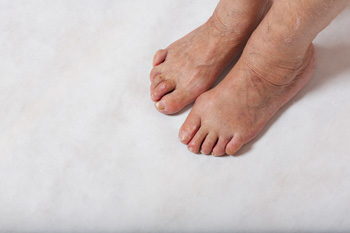
A hammertoe is when a toe is stuck in an upward bent position in the middle joint. It is one of the most common deformities of the forefoot. It can cause pain, swelling, redness, and callus formation on parts of the toe that rubs against shoes. Having a hammertoe can cause trouble with walking, maintaining balance, and doing other activities. Hammertoes can happen when the small muscles on the bottom of the foot are weaker than the larger muscles on the top of the foot. Hammertoes are more common among those with flat feet and longer metatarsals and those with diabetes or inflammatory arthropathies because these conditions affect the muscles, tendons, and nerves in the feet. One can also get a hammertoe from wearing shoes with heels that put pressure on the tips of the toes. Treatment options for hammertoe include stretches and exercises, taping, or surgery. If you have a hammertoe, see a chiropodist who can provide suggestions and treatment to increase your comfort.
Hammertoe is a common foot deformity in which one or more of the small toes bends downwards at the middle joint. Though it may seem like a purely cosmetic issue, this is not the case. Hammertoes can be uncomfortable, painful, and even debilitating in severe cases. If you suffer from hammertoe, please consult with one of the chiropodists from Complete Family Footcare & Therapy. Our clinicians can help you maintain the health of your lower limbs and your mobility.
Symptoms
One or more small toes bending downward at the middle joint
Pain or irritation on the affected toes
Corns and calluses
Inflammation
Redness
Stiff toe joints
Sores on the tops of the toes
Diagnosis
A chiropodist can typically diagnose hammertoes through physical examination. X-rays may need to be taken to see the extent of the damage.
Treatment
Hammertoes tend to progressively worsen with time, so getting prompt treatment is very important. In its early stages, the progression of hammertoe can be slowed down or stopped. Your chiropodist may suggest changes in your footwear. Wearing wide, comfortable shoes with a larger toe area and a low heel can help you avoid putting pressure on your toes. You may also be prescribed orthotics. Over-the-counter medications or corticosteroid injections may be used to relieve pain. If you have any corns or calluses, your chiropodist may suggest padding them to avoid further irritation. In advanced cases, surgery may be suggested.
If you have any questions, please feel free to contact our offices located in . We offer the newest diagnostic and treatment technologies for all your foot care needs.
